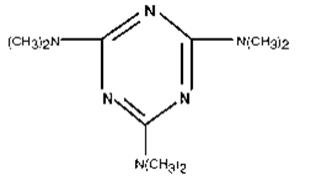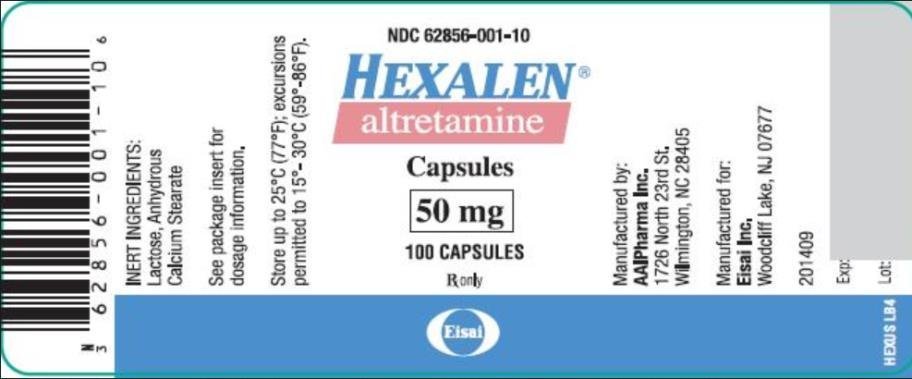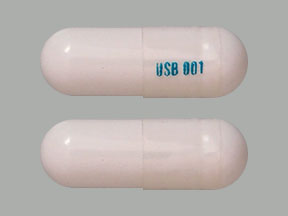Hexalen: Package Insert / Prescribing Info
Package insert / product label
Generic name: altretamine
Dosage form: capsule
Drug class: Miscellaneous antineoplastics
Medically reviewed by Drugs.com. Last updated on Nov 11, 2024.
On This Page
WARNINGS
1. HEXALEN® capsules should only be given under the supervision of a physician experienced in the use of antineoplastic agents.
2. Peripheral blood counts should be monitored at least monthly, prior to the initiation of each course of HEXALEN® capsules, and as clinically indicated (see Adverse Reactions).
3. Because of the possibility of HEXALEN® capsules-related neurotoxicity, neurologic examination should be performed regularly during HEXALEN® capsules administration (see Adverse Reactions).
Hexalen Description
HEXALEN® (altretamine) capsules, is a synthetic cytotoxic antineoplastic s-triazine derivative. HEXALEN® capsules contain 50 mg of altretamine for oral administration. Inert ingredients include lactose, anhydrous and calcium stearate. Altretamine, known chemically as N,N,N’,N’,N”,N”-hexamethyl-1,3,5-triazine-2,4,6-triamine, has the following structural formula:

Its empirical formula is C9H18N6 with a molecular weight of 210.28. Altretamine is a white crystalline powder, melting at 172°± 1°C. Altretamine is practically insoluble in water but is increasingly soluble at pH 3 and below.
Hexalen - Clinical Pharmacology
The precise mechanism by which HEXALEN® capsules exerts its cytotoxic effect is unknown, although a number of theoretical possibilities have been studied. Structurally, HEXALEN® capsules resembles the alkylating agent triethylenemelamine, yet in vitro tests for alkylating activity of HEXALEN® capsules and its metabolites have been negative. HEXALEN® capsules has been demonstrated to be efficacious for certain ovarian tumors resistant to classical alkylating agents. Metabolism of altretamine is a requirement for cytotoxicity. Synthetic monohydroxymethylmelamines, and products of altretamine metabolism, in vitro and in vivo, can form covalent adducts with tissue macromolecules including DNA, but the relevance of these reactions to antitumor activity is unknown.
HEXALEN® capsules is well-absorbed following oral administration in humans, but undergoes rapid and extensive demethylation in the liver, producing variation in altretamine plasma levels. The principal metabolites are pentamethylmelamine and tetramethylmelamine.
Pharmacokinetic studies were performed in a limited number of patients and should be considered preliminary. After oral administration of HEXALEN® capsules to 11 patients with advanced ovarian cancer in doses of 120-300 mg/m2, peak plasma levels (as measured by gas-chromatographic assay) were reached between 0.5 and 3 hours, varying from 0.2 to 20.8 mg/l. Half-life of the ß-phase of elimination ranged from 4.7 to 10.2 hours. Altretamine and metabolites show binding to plasma proteins. The free fractions of altretamine, pentamethylmelamine and tetramethylmelamine are 6%, 25% and 50%, respectively.
Following oral administration of 14C-ring-labeled altretamine (4 mg/kg), urinary recovery of radioactivity was 61% at 24 hours and 90% at 72 hours. Human urinary metabolites were N-demethylated homologues of altretamine with <1% unmetabolized altretamine excreted at 24 hours.
After intraperitoneal administration of 14C-ring-labeled altretamine to mice, tissue distribution was rapid in all organs, reaching a maximum at 30 minutes. The excretory organs (liver and kidney) and the small intestine showed high concentrations of radioactivity, whereas relatively low concentrations were found in other organs, including the brain.
There have been no formal pharmacokinetic studies in patients with compromised hepatic and/or renal function, though HEXALEN® capsules has been administered both concurrently and following nephrotoxic drugs such as cisplatin.
HEXALEN® capsules has been administered in 4 divided doses, with meals and at bedtime, though there is no pharmacokinetic data on this schedule nor information from formal interaction studies about the effect of food on its bioavailability or pharmacokinetics.
In two studies in patients with persistent or recurrent ovarian cancer following first-line treatment with cisplatin and/or alkylating agent-based combinations, HEXALEN® capsules was administered as a single agent for 14 or 21 days of a 28 day cycle. In the 51 patients with measurable or evaluable disease, there were 6 clinical complete responses, 1 pathologic complete response, and 2 partial responses for an overall response rate of 18%. The duration of these responses ranged from 2 months in a patient with a palpable pelvic mass to 36 months in a patient who achieved a pathologic complete response. In some patients, tumor regression was associated with improvement in symptoms and performance status.
Indications and Usage for Hexalen
HEXALEN® (altretamine) capsules is indicated for use as a single agent in the palliative treatment of patients with persistent or recurrent ovarian cancer following first-line therapy with a cisplatin and/or alkylating agent-based combination.
Contraindications
HEXALEN® capsules is contraindicated in patients who have shown hypersensitivity to it. HEXALEN® capsules should not be employed in patients with preexisting severe bone marrow depression or severe neurologic toxicity. HEXALEN® capsules has been administered safely, however, to patients heavily pretreated with cisplatin and/or alkylating agents, including patients with preexisting cisplatin neuropathies. Careful monitoring of neurologic function in these patients is essential.
Warnings
See boxed Warnings.
Concurrent administration of HEXALEN® capsules and antidepressants of the monoamine oxidase (MAO) inhibitor class may cause severe orthostatic hypotension. Four patients, all over 60 years of age, were reported to have experienced symptomatic hypotension after 4 to 7 days of concomitant therapy with HEXALEN® capsules and MAO inhibitors.
HEXALEN® capsules causes mild to moderate myelosuppression and neurotoxicity. Blood counts and a neurologic examination should be performed prior to the initiation of each course of therapy and the dose of HEXALEN® capsules adjusted as clinically indicated (see Dosage and Administration).
HEXALEN® capsules has been shown to be embryotoxic and teratogenic in rats and rabbits when given at doses 2 and 10 times the human dose. HEXALEN® capsules may cause fetal damage when administered to a pregnant woman. If HEXALEN® capsules is used during pregnancy, or if the patient becomes pregnant while taking the drug, the patient should be apprised of the potential hazard to the fetus. Women of childbearing potential should be advised to avoid becoming pregnant.
Precautions
Laboratory Tests
Peripheral blood counts should be monitored at least monthly, prior to the initiation of each course of HEXALEN® capsules, and as clinically indicated (see Adverse Reactions).
Drug Interactions
Concurrent administration of HEXALEN® capsules and antidepressants of the MAO inhibitor class may cause severe orthostatic hypotension (see Warnings section). Cimetidine, an inhibitor of microsomal drug metabolism, increased altretamine’s half-life and toxicity in a rat model.
Data from a randomized trial of HEXALEN® capsules and cisplatin plus or minus pyridoxine in ovarian cancer indicated that pyridoxine significantly reduced neurotoxicity; however, it adversely affected response duration suggesting that pyridoxine should not be administered with HEXALEN® capsules and/or cisplatin (1).
Carcinogenesis, Mutagenesis and Impairment of Fertility
The carcinogenic potential of HEXALEN® capsules has not been studied in animals, but drugs with similar mechanisms of action have been shown to be carcinogenic. HEXALEN® capsules was weakly mutagenic when tested in strain TA100 of Salmonella typhimurium. HEXALEN® capsules administered to female rats 14 days prior to breeding through the gestation period had no adverse effect on fertility, but decreased post-natal survival at 120 mg/m2/day and was embryocidal at 240 mg/m2/day. Administration of 120 mg/m2/day HEXALEN® capsules to male rats for 60 days prior to mating resulted in testicular atrophy, reduced fertility and a possible dominant lethal mutagenic effect. Male rats treated with HEXALEN® capsules at 450 mg/m2/day for 10 days had decreased spermatogenesis, atrophy of testes, seminal vesicles and ventral prostate.
Adverse Reactions/Side Effects
Gastrointestinal
With continuous high-dose daily HEXALEN® capsules, nausea and vomiting of gradual onset occur frequently. Although in most instances these symptoms are controllable with anti-emetics, at times the severity requires HEXALEN® capsules dose reduction or, rarely, discontinuation of HEXALEN® capsules therapy. In some instances, a tolerance of these symptoms develops after several weeks of therapy. The incidence and severity of nausea and vomiting are reduced with moderate-dose administration of HEXALEN® capsules. In 2 clinical studies of single-agent HEXALEN® capsules utilizing a moderate, intermittent dose and schedule, only 1 patient (1%) discontinued HEXALEN® capsules due to severe nausea and vomiting.
Neurotoxicity
Peripheral neuropathy and central nervous system symptoms (mood disorders, disorders of consciousness, ataxia, dizziness, vertigo) have been reported. They are more likely to occur in patients receiving continuous high-dose daily HEXALEN® (altretamine) capsules than moderate-dose HEXALEN® capsules administered on an intermittent schedule. Neurologic toxicity has been reported to be reversible when therapy is discontinued. Data from a randomized trial of HEXALEN® capsules and cisplatin plus or minus pyridoxine in ovarian cancer indicated that pyridoxine significantly reduced neurotoxicity; however, it adversely affected response duration suggesting that pyridoxine should not be administered with HEXALEN® capsules and/or cisplatin (1).
Hematologic
HEXALEN® capsules causes mild to moderate dose-related myelosuppression. Leukopenia below 3000 WBC/mm3 occurred in <15% of patients on a variety of intermittent or continuous dose regimens. Less than 1% had leukopenia below 1000 WBC/mm3. Thrombocytopenia below 50,000 platelets/mm3 was seen in <10% of patients. When given in doses of 8-12 mg/kg/day over a 21 day course, nadirs of leukocyte and platelet counts were reached by 3-4 weeks, and normal counts were regained by 6 weeks. With continuous administration at doses of 6-8 mg/kg/day, nadirs are reached in 6-8 weeks (median).
Data in the following table are based on the experience of 76 patients with ovarian cancer previously treated with a cisplatin-based combination regimen who received single-agent HEXALEN® capsules. In one study, HEXALEN® capsules, 260 mg/m2/day, was administered for 14 days of a 28 day cycle. In another study, HEXALEN® capsules, 6-8 mg/kg/day, was administered for 21 days of a 28 day cycle.
ADVERSE EXPERIENCES IN 76 PREVIOUSLY
TREATED OVARIAN CANCER PATIENTS
RECEIVING SINGLE-AGENT HEXALEN® CAPSULES
| Adverse Experiences | % Patients |
| Gastrointestinal
Nausea and Vomiting Mild to Moderate Severe Increased Alkaline Phosphatase | 33 32 1 9 |
| Neurologic
Peripheral Sensory Neuropathy Mild Moderate to Severe Anorexia and Fatigue Seizures | 31 22 9 1 1 |
| Hematologic
Leukopenia WBC 2000-2999/mm3 WBC <2000/mm3 Thrombocytopenia Platelets 75,000-99,000/mm3 Platelets <75,000/mm3 Anemia Mild Moderate to Severe | 5 4 1 9 6 3 33 20 13 |
| Renal
Serum Creatinine 1.6-3.75 mg/dl BUN 25-40 mg% 41 -60 mg% >60 mg% | 7 9 5 3 1 |
Additional adverse reaction information is available from 13 single-agent altretamine studies (total of 1014 patients) conducted under the auspices of the National Cancer Institute. The treated patients had a variety of tumors and many were heavily pretreated with other chemotherapies; most of these trials utilized high, continuous daily doses of altretamine (612 mg/kg/day). In general, adverse reaction experiences were similar in the two trials described above. Additional toxicities, not reported in the above table, included hepatic toxicity, skin rash, pruritus and alopecia, each occurring in <1% of patients.
Overdosage
No case of acute overdosage in humans has been described. The oral LD50 dose in rats was 1050 mg/kg and 437 mg/kg in mice.
Hexalen Dosage and Administration
HEXALEN® capsules is administered orally. Doses are calculated on the basis of body surface area.
HEXALEN® capsules may be administered either for 14 or 21 consecutive days in a 28 day cycle at a dose of 260 mg/m2/day. The total daily dose should be given as 4 divided oral doses after meals and at bedtime. There is no pharmacokinetic information supporting this dosing regimen and the effect of food on HEXALEN® capsules bioavailability or pharmacokinetics has not been evaluated.
HEXALEN® capsules should be temporarily discontinued (for 14 days or longer) and subsequently restarted at 200 mg/m2/day for any of the following situations:
- Gastrointestinal intolerance unresponsive to symptomatic measures;
- White blood count <2000/mm3 or granulocyte count <1000/mm3;
- Platelet count <75,000/mm3;
- Progressive neurotoxicity.
If neurologic symptoms fail to stabilize on the reduced dose schedule, HEXALEN® capsules should be discontinued indefinitely.
Procedures for proper handling and disposal of anticancer drugs should be considered. Several guidelines on this subject have been published (2-9). There is no general agreement that all of the procedures recommended in the guidelines are necessary or appropriate.
How is Hexalen supplied
HEXALEN® (altretamine) capsules is available in 50 mg clear, hard gelatin capsules imprinted with the following inscription:
USB 001.
Bottles of 100 capsules
(NDC 62856-001-10)
Store up to 25ºC (77ºF); excursions permitted to 15° to 30°C (59° to 86°F).
References
1. Wiernik PH, et al. Hexamethylmelamine and Low or Moderate Dose Cisplatin With or Without Pyridoxine for Treatment of Advanced Ovarian Carcinoma: A Study of the Eastern Cooperative Oncology Group. Cancer Invest. 1992; 10(1): 1-9.
2. ONS Clinical Practice Committee. Cancer Chemotherapy Guidelines and Recommendations for Practice. Pittsburgh, Pa: Oncology Nursing Society; 1999:32-41.
3. U.S. Department of Health and Human Services. Recommendations for the Safe Handling of Parenteral Antineoplastic Drugs. Washington DC: Division of Safety, National Institutes of Health; 1983 Public Health Service publication NIH 83-2621.
4. AMA Council on Scientific Affairs. Guidelines for Handling Parenteral Antineoplastics. JAMA. 1985; 253:1590-1591.
5. National Study Commission on Cytotoxic Exposure. Recommendations for Handling Cytotoxic Agents. Boston, MA: Available from Louis P. Jeffrey, Chairman, National Study Commission on Cytotoxic Exposure, Massachusetts College of Pharmacy and Allied Health Sciences, 179 Longwood Avenue, Boston, MA 02115; 1987.
6. Clinical Oncological Society of Australia: Guidelines and Recommendations for Safe Handling of Antineoplastic Agents. Med J Australia. 1983;1:426-428.
7. Jones RB, Frank R, Mass T. Safe Handling of Chemotherapeutic Agents: A Report from the Mount Sinai Medical Center. CA Cancer J Clin. 1983;33:258-263.
8. American Society of Hospital Pharmacists. ASHP Technical Assistance Bulletin on Handling Cytotoxic and Hazardous Drugs. Am J Hosp Pharm. 1990; 47:1033-1049.
9. OSHA Work Practice Guidelines. Controlling Occupational Exposure to Hazardous Drugs. Am J Health Syst Pharm. 1996;53:1669-1685.
HEXALEN® (altretamine) capsules is a registered trademark of Eisai Inc.
Manufactured by:
AAIPharma Inc.
Wilmington, NC 28405
Manufactured for:
Eisai Inc.
Woodcliff Lake, NJ 07677
For Medical Inquiries call: 1-877-873-4724
Revision Date June 2018
| HEXALEN
altretamine capsule |
||||||||||||||||||
|
||||||||||||||||||
|
||||||||||||||||||
|
||||||||||||||||||
|
||||||||||||||||||
|
||||||||||||||||||
|
||||||||||||||||||
| Labeler - Eisai Inc. (831600833) |
More about Hexalen (altretamine)
- Check interactions
- Compare alternatives
- Reviews (1)
- Drug images
- Side effects
- Dosage information
- During pregnancy
- Drug class: miscellaneous antineoplastics


